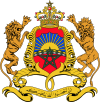
Back تاريخ المغرب Arabic تاريخ د لمغريب ARY حضارات وممالك المغرب ARZ Historia de Marruecos AST Гісторыя Марока Byelorussian মরক্কোর ইতিহাস Bengali/Bangla Historija Maroka BS Història del Marroc Catalan Dějiny Maroka Czech Geschichte Marokkos German
| History of Morocco |
|---|
 |
The history of human habitation in Morocco spans since the Lower Paleolithic, with the earliest known being Jebel Irhoud. Much later Morocco was part of Iberomaurusian culture, including Taforalt. It dates from the establishment of Mauretania and other ancient Berber kingdoms, to the establishment of the Moroccan state by the Idrisid dynasty[1] followed by other Islamic dynasties, through to the colonial and independence periods.
Archaeological evidence has shown that the area was inhabited by hominids at least 400,000 years ago.[2] The recorded history of Morocco begins with the Phoenician colonization of the Moroccan coast between the 8th and 6th centuries BCE,[3] although the area was inhabited by indigenous Berbers for some two thousand years before that. In the 5th century BCE, the city-state of Carthage extended its hegemony over the coastal areas.[4] They remained there until the late 3rd century BCE,[5] while the hinterland was ruled by indigenous monarchs.[4] Indigenous Berber monarchs ruled the territory from the 3rd century BCE until 40 CE, when it was annexed to the Roman Empire. In the mid-5th century CE, it was overrun by Vandals, before being recovered by the Byzantine Empire in the 6th century.
The region was conquered by the Muslims in the early 8th century CE, but broke away from the Umayyad Caliphate after the Berber Revolt of 740. Half a century later, the Moroccan state was established by the Idrisid dynasty.[6][1] The Saadi dynasty ruled the country from 1549 to 1659, followed by the Alawis from 1667 onwards, who have since been the ruling dynasty of Morocco.[7][8][9]
- ^ a b "Moroccan dynastic shurfa' -hood in two historical contexts: idrisid cult and 'Alawid power". The Journal of North African Studies. 6 (2): 81–94. June 2001. doi:10.1080/13629380108718436. S2CID 219626270.
- ^ Cite error: The named reference
Hublinwas invoked but never defined (see the help page). - ^ Cite error: The named reference
Pe5was invoked but never defined (see the help page). - ^ a b Pennell 2003, pp.7–9
- ^ Pennell 2003, pp.9–11
- ^ "tradition (...) reaches back to the origins of the modern Moroccan state in the ninth century Idrisid dynasty which founded the venerable city of. Fes", G Joffe, Morocco: Monarchy, legitimacy and succession, in : Third World Quarterly, 1988
- ^ "The CBS News Almanac", Hammond Almanac Inc., 1976, p.783: "The Alaouite dynasty (Filali) has ruled Morocco since the 17th century"
- ^ Hans Groth & Alfonso Sousa-Poza, "Population Dynamics in Muslim Countries: Assembling the Jigsaw", Springer, 2012 (ISBN 9783642278815). p.229: "The Alaouite dynasty has ruled Morocco since the days of Mulai ar-Rashid (1664–1672)"
- ^ Joseph L. Derdzinski, "Internal Security Services in Liberalizing States: Transitions, Turmoil, and (In)Security", Ashgate Publishing Ltd., 2013 (ISBN 9781409499015). p.47: "Hassan in 1961, after the death of his father Mohammed V, continued the succession of Alaouite rule in Morocco since the seventeenth century"